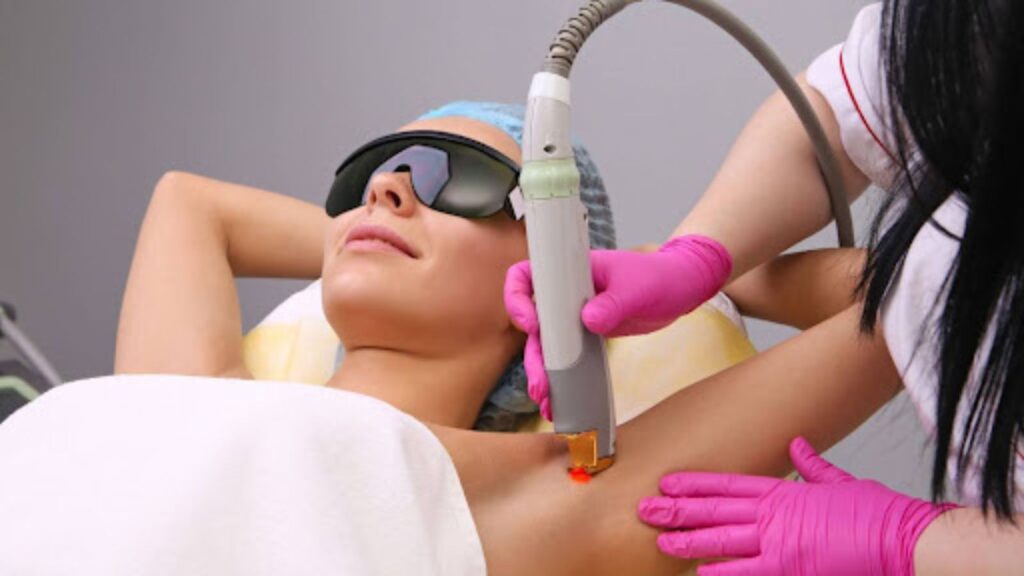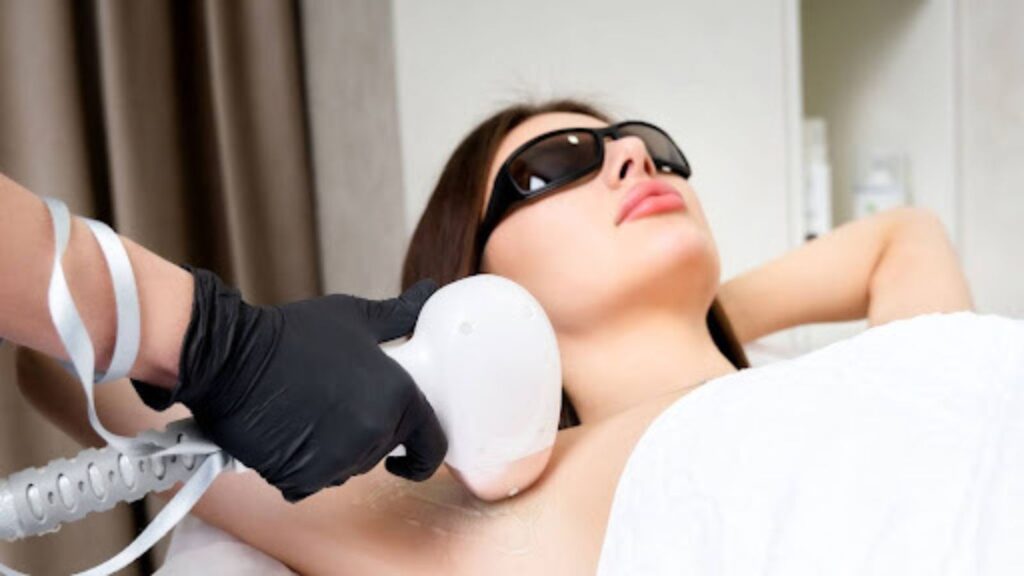Traditional hair removal methods like waxing, tweezing, and shaving are time-consuming and require much effort. They also need to be repeated frequently and can be quite painful.
Laser hair removal machines have become increasingly popular and are now one of the most commonly performed hair removal procedures. Laser hair removal machines use a concentrated beam of light to damage or destroy the hair follicle by targeting the pigment of the hair being removed. The damage to the hair follicle during this treatment is minimal. It usually takes two to three sessions to remove hair and inhibit regrowth. This process is typically performed on the chin, upper lip, armpits, legs, etc. The effectiveness of a laser hair removal treatment depends on skin color and hair. Generally, the treatment is most effective when there is a higher contrast between them. So, it works best when the hair is dark, and the skin is light. The effectiveness for white or blonde hair is lower.
How Does Laser Hair Removal Machine Work?
A laser hair removal machine employs a process known as selective photothermolysis. The heat from a laser damages pigment-rich cells. Dark hair absorbs the greatest heat since it contains a high pigment concentration. Hair distributes heat to the hair follicles, destroying them, and preventing hair from growing. The treatment requires a hair follicle to be in the anagen or growth stage. Follicles change phases at various times, therefore most people require numerous laser treatments.
Laser Hair Removal Is Suitable For
Anyone with excess body hair can receive laser hair removal. It is a cosmetic procedure that can improve one’s attractiveness or self-esteem. Many individuals choose not to shave regularly.
Laser hair removal may be used to address excessive hair growth caused by:

- Hirsutism: occurs when women develop dark or coarse hair in areas where males typically have hair.
- Hypertrichosis: occurs when women or men develop excessive hair on their bodies.
These conditions can be caused by:
- Several drugs, including birth control pills and anabolic steroids.
- Hormone imbalances, particularly high androgen or testosterone levels.
- Inherited diseases are conditions passed on by parents via genes.
- Polycystic Ovarian Syndrome (PCOS).
- hormone-producing tumors.
Laser hair removal is particularly effective for persons with thick, black hair and fair complexion. The contrast between skin and hair color allows the hair to absorb heat better. People with dark complexion or gray, blonde, red, or white hair may find it less effective.
Laser Hair Removal Is Not Suitable For
Consult your doctor before undergoing laser hair removal. The following individuals should skip the treatment:
- Pregnant women.
- Individuals using specific drugs, like acne treatments.
- Individuals having genital herpes (HSV-2) or are susceptible to cold sores.
- Have elevated scars.
- Experienced or currently experienced skin cancer.
Risks Associated With Laser Hair Removal
The risk of side effects varies depending on hair color, skin type, treatment strategy, and attention to pre and post-treatment care. The most prevalent side effects of laser hair removal are:
- Skin irritation: Following laser hair removal, you may have temporary pain, swelling, or redness. Any symptoms or signs usually fade within a few hours.
- Pigment alterations: Laser hair removal can lighten or darken the treated skin, and these alterations can be permanent or temporary. Skin lightening typically affects people who do not prevent sun exposure before or after the procedure and those with darker skin.
Laser hair removal can rarely cause scarring, crusting, blistering, or other skin texture changes. Other uncommon side effects involve graying of targeted hair or heavy hair growth surrounding treated areas, especially on darker skin. Laser hair removal is not recommended for the brows, eyelids, or nearby areas because of the risk of serious eye injury.
How To Prepare For Laser Hair Removal
If you are considering laser hair removal, it is recommended that you choose a doctor who is board-certified in a specialty such as dermatology or cosmetic surgery and has experience with laser hair removal on your skin type. If a physician assistant or licensed nurse is performing the procedure, ensure that a doctor is supervising and available on-site during the treatments. Be careful of spas, salons, or other establishments allowing non-medical staff to remove laser hair.
Before undergoing laser hair removal, you must schedule a consultation with the doctor to determine if this is an appropriate treatment option. During the consultation, the doctor will:
- Examine your medical history, including medication usage, history of skin diseases or scars, and previous hair removal treatments.
- Discuss the procedure’s advantages, hazards, and expectations, including what laser hair removal can and cannot achieve for you.
- Take images for before-and-after assessments, as well as long-term appraisals.
- You should also discuss a treatment plan and associated charges at the appointment, as laser hair removal is often an out-of-pocket payment.
The doctor will also provide specific instructions to prepare for laser hair removal. These might include:
- Staying out of the sun: You should follow your doctor’s advice for avoiding sun exposure before and after treatment. Use a broad-spectrum sunscreen while going out.
- Lightening your skin: Stay away from sunless skin lotions that darken your skin. Your doctor may recommend a skin-whitening cream if you’ve recently tanned or have darker skin.
- Avoiding other hair removal methods: Waxing, plucking, and electrolysis can disturb the hair follicle and should be avoided at least four weeks before treatment.
- Avoiding blood thinners: Consult your doctor about which medications, such as aspirin or anti-inflammatory treatments, should be avoided before the procedure.
- Shaving the treatment area: Trimming and shaving the area the day before laser treatment is recommended. This removes the hair above the skin, which can result in surface skin damage from burnt hairs, but leaves the hair shaft intact below the surface.
What To Expect
Laser hair removal usually takes 2 to 6 treatment sessions. The time between treatments will vary according to the area. In areas where hair grows faster, such as the upper lip, the procedure can be repeated in 4 to 8 weeks. Treatments for sluggish hair growth areas, such as the back, may be repeated every 12 to 16 weeks. Each treatment requires wearing special goggles to protect your eyes from the laser beam. If required, a helper can reshave the area. The doctor may apply an anesthetic cream to your skin to alleviate discomfort or pain during the procedure.

During The Laser Hair Removal Procedure
The doctor will use handheld laser equipment on your skin. A cooling device attached to the instrument’s tip or a cold gel may protect your skin and reduce the chance of side effects depending on the laser type. When the doctor activates the laser, the beam travels through your skin to the hair follicles. The laser beam’s extreme heat causes damage to the hair follicles, limiting hair growth. You may experience discomfort, such as a heated pinprick and a cooling feeling from the device or gel. Treating a limited area, such as the upper lip, may just take a few minutes. Treating a bigger area like the back may need around an hour or more.
After The Laser Hair Removal Procedure
You can experience swelling and redness during the first few hours following laser hair removal. To alleviate any discomfort, apply ice to the targeted area. If you experience a skin response immediately following laser hair removal, your doctor may prescribe a steroid cream for the affected part. Avoid sun exposure and tanning beds for six weeks after laser hair removal, or as instructed by your doctor. Apply a broad-spectrum sunscreen regularly.
Results Of Laser Hair Removal
Hairs do not come out immediately; instead, they shed over many days to weeks. This may appear to be continuous hair growth. Repeated treatments are usually necessary since hair growth and loss occur in cycles, and a laser hair removal system works best on hair follicles during the new-growth phase. The results vary greatly and are hard to predict. Many people have hair removal that lasts for months and even years. However, laser hair removal does not ensure permanent hair removal. When hair regrows, it is often finer and lighter in color. You may require maintenance laser hair removal sessions for long-term results.
Laser Hair Removal Machine For Home Use
There are laser hair removal machines available for home use. These devices may cause minor hair loss. However, no large-scale studies have been conducted to compare the effectiveness of these devices to laser hair removal performed in a doctor’s office. The United States Food and Drug Administration deems these home laser hair removal machines to be cosmetic rather than medicinal, therefore they do not receive the same scrutiny as other machines.
If you decide to use a home laser hair removal machine, follow the guidelines provided to help decrease the chance of side effects, particularly eye problems. Moreover, home-use laser hair removal machines are cheaper and easy to use. These machines are safe to use when used according to the manufacturer’s instructions.
Takeaway
Hopefully, you have answers to all your questions about laser hair removal machines and who can benefit from the treatment. Laser hair removal is a highly effective procedure that can save you from the hassle of spending countless hours on waxing, plucking, and shaving. With this treatment, you can confidently avoid any embarrassing situations in the future due to a lack of planning. Additionally, home-use laser hair removal machines make it easy and convenient to zap away unwanted hair quickly and safely without leaving your home.
